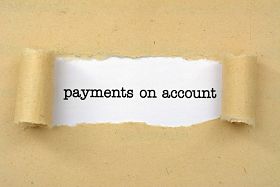Payments on account are one of the most commonly misunderstood aspects of the self-assessment process and although the intention is to help self-employed people spread out their tax bill, the advantages might not seem so apparent when you ‘re first asked to pay a whopping big tax bill up front.
What are payments on account?
Payments on account are the amount of Income tax and Class 4 National Insurance that you may have to pay in advance towards your next tax bill. The amounts don’t include Class 2 National insurance, student loan repayments or Capital gains tax.
So, why pay tax in advance? When you were employed, HMRC received your tax monthly following deduction from your salary. When you become self-employed, there is a much longer waiting time before HMRC receives your tax. To reduce this waiting time, a system of payments on account was introduced to shorten the tax time lag for HMRC.
Do all sole traders come under the payments on account system?
Not necessarily but If your tax bill for the year (that you completing your self-assessment) is more than £1,000 and less than 80% of this amount has already been deducted at source (tax taken off before you receive the income e.g. salary) you will have to make payments on account.
Here’s an example:
Emma works part-time in a book shop earning a salary. She also starts up a sole trade photography business.
Emma’s tax bill for the 2016-17 tax year is £1,400.
£1,200 of this had been deducted as PAYE on her salary (tax deducted at source)
As the tax collected at source is more than 80% of the tax bill, Emma won’t have to make payments on account towards the next tax year, 2017-18 in respect of her photography business.
 If Emma’s tax bill for 2016-17 tax year had been £1,400 but no tax had been deducted at source then because her tax bill came to more than £1,000, she will now have to enter into the payments on account system.
If Emma’s tax bill for 2016-17 tax year had been £1,400 but no tax had been deducted at source then because her tax bill came to more than £1,000, she will now have to enter into the payments on account system.
Now we’re going to look at some examples of how the system works.
How are payments on account calculated?
The first year that Emma enters into the payments on account system
If we look at the second example of Emma’s tax position in 2016/17, she is due to pay a total tax bill of £1,400
As she qualifies for the payments on account system she will also have to make advance payments towards the next tax year 2017/18. This is payable in two instalments with 50% due a year early and 50% 6 months early.
Payments on account are calculated by taking the tax bill (Class 4 NI and Income tax) for 2016/17 and dividing this by two. In Emma’s case this will be £700 paid in two instalments. The first payment on account (POA) is due at the time that Emma has to pay her 2016/17 tax liability (31st January 2018) and the second instalment is paid by 31st July 2018.
Therefore, at 31st January 2018, Emma must pay:
Tax liability for 2016/17 of £1,400 plus her first POA for 2017/18 of £700 making a total of £2,100
 Her Second POA is due by 31st July 2018 and Emma must pay:
Her Second POA is due by 31st July 2018 and Emma must pay:
Tax of £700 in respect of 2017/18
So, by the end of July 2018 Emma will have paid a whopping £2,800 of tax in respect of 2016/17 and 2017/18.
Thankfully, the situation gets a little easier from here on.
The second year
Emma’s Actual tax bill for 2017-18 tax year comes to £1,500
But, remember that Emma has already paid an amount up front towards the 2017-18 tax year (£1,400 in two instalments). This means that when it comes to paying her tax for 2017-18 she only needs to pay £100 more on 31st January 2018. This is called a balancing payment.
Don’t forget that the POA towards 2018-19 tax year needs to be calculated (half of the £1,500 tax bill) and the first POA paid by 31st January 2019.
Tax due by 31st January 2019:
Balancing payment towards 2017-18 tax year of £100
Plus: first POA towards 2018-19 tax year of £750
Total tax due: £850
Tax due by 31st July 2019:
Second POA towards 2018-18 tax year of £750
What can you learn……
You can see now, why coming into the payments on account system for the first time can result in you paying one and a half times your tax bill by the 31st January following the end of your tax year. It’s a tough scenario to come to terms with if you haven’t been paying tax via self-assessment or are new to self-employment. But, there are several steps you can take to alleviate some of the shock and cash-flow difficulties that might arise.
1 – Submit your tax return early
You can complete and submit your tax return any time after the end of the tax year, 5th April so why not go ahead and establish what you owe early on. At least you’ve then got more time to make a plan to start saving for the required amount.
We’ve talked about what happens if you make payments on account that are short of your final tax liability but what happens if your payments on account are more than your final tax liability? By submitting your tax return early HMRC will refund you tax and generally this is received fairly promptly.
You may be fed up with your accountant nagging you to get your figures in order but there are sound financial reasons why it pays to submit your tax return early. You can read more in 10 reasons why it pays to submit your tax return early
2 – Save wisely
 Every time you bank your hard earned income, try not to mentally spend away this money. Syphon off a portion (20% is a good benchmark) and ring fence these funds for future tax payments. Just think, if you were still in employment, tax is deducted from your salary and paid over to HMRC on your behalf each month.
Every time you bank your hard earned income, try not to mentally spend away this money. Syphon off a portion (20% is a good benchmark) and ring fence these funds for future tax payments. Just think, if you were still in employment, tax is deducted from your salary and paid over to HMRC on your behalf each month.
What happens if my profits start to fall?
What happens if you know your profits are going to fall next year and you don’t want to pay such high POA? What happens if you can’t pay the amount of tax? POA is one of the hardest aspects of the self-assessment process for sole traders to grasp and rather than cramming my content into one blog I have decided to continue my ramblings in a ‘part two’. If you’re a sole trader running your own business and looking for more helpful tips and inspiration, feel free to sign up here. Needing some ongoing support with your tax, you can drop me a line. I’d love to hear from you.
Over to you
I hope this post has been helpful? Do leave any comments in the box below and if you’ve enjoyed this post please consider sharing with other small business owners using the buttons below. It would mean so much if you did.
